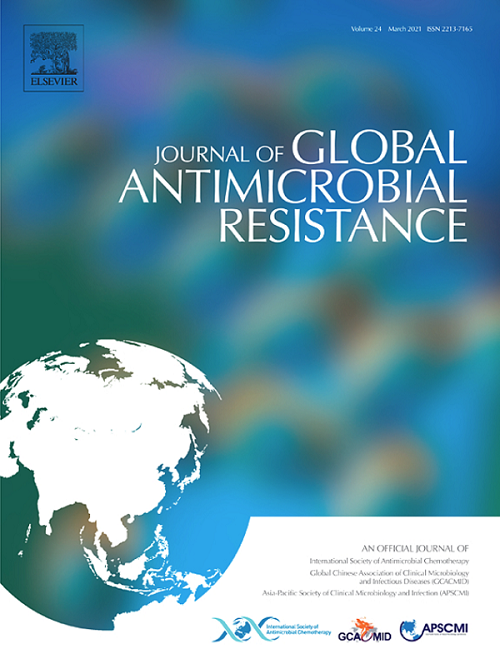Investigation of genomic islands involved in antimicrobial resistance in Proteus mirabilis isolated from swine
IF 3.2
3区 医学
Q2 INFECTIOUS DISEASES
引用次数: 0
Abstract
Objectives
Proteus mirabilis (P. mirabilis), a Gram-negative, rod-shaped bacterium, is ubiquitously present in natural environments as well as within the intestinal tracts of humans and animals. We isolated P. mirabilis SH-4 from a swine sample and investigated its antibiotic resistance genes (ARGs) along with their genetic structure.
Methods
In this study, we have performed antimicrobial susceptibility testing by the broth microdilution method and conducted a comprehensive analysis through whole genome sequencing (WGS) and phylogenomics of P. mirabilis strain SH-4.
Results
P. mirabilis SH-4 was found to possess a single chromosome measuring 4 123 479 base pairs in length, with a GC content of 39.06%. Besides, P. mirabilis SH-4 exhibited resistance to eleven antimicrobial agents tested. Through single nucleotide polymorphism (SNP) profiling, we revealed the genetic relationship of SH-4 with other P. mirabilis strains carrying various ARGs. WGS analysis revealed that SH-4 harbored a ΔTn7 transposon and two distinct genomic islands (GIs), designated as PmGRI-9-SH-4 and PmGRI-10-SH-4. ΔTn7 was identified, corresponding to Tn7 with an insertion of IS256 within its sequence. PmGRI-9-SH-4 displayed partial homology to PmGRI1-STP3 and PmGRI1-YN9 (China:Sichuan). Additionally, PmGRI-10-SH-4 contained composite transposons and eleven Type IV secretion system (T4SS) related genes, including traN, traU, traC, and others, with the MDR region situated near the terminus of this GI.
Conclusions
In summary, GIs and ISs may serve as crucial facilitators in the acquisition of resistance genes in P. mirabilis. These genetic elements turn P. mirabilis into highly resistant bacteria, culminating in infections that pose significant therapeutic challenges.
猪源奇异变形杆菌抗微生物基因岛的研究。
目的:奇异变形杆菌(P. mirabilis)是一种革兰氏阴性杆状细菌,普遍存在于自然环境以及人类和动物的肠道内。我们从猪样本中分离出神奇假单胞菌SH-4,并对其抗生素耐药基因(ARGs)及其遗传结构进行了研究。方法:本研究采用微量肉汤稀释法对菌株SH-4进行药敏试验,并通过全基因组测序和系统基因组学对菌株SH-4进行综合分析。结果:发现P. mirabilis SH-4单染色体长度为4123479个碱基对,GC含量为39.06%。此外,P. mirabilis SH-4对11种抗菌药物均表现出耐药性。通过单核苷酸多态性(SNP)分析,我们揭示了SH-4与其他携带多种ARGs的奇异假单胞菌的遗传关系。WGS分析显示,SH-4含有一个ΔTn7转座子和两个不同的基因组岛(GIs),分别为PmGRI-9-SH-4和PmGRI-10-SH-4。鉴定出ΔTn7,对应于Tn7,在其序列中插入IS256。pmgrii -9- sh -4与PmGRI1-STP3和PmGRI1-YN9(中国:四川)具有部分同源性。此外,PmGRI-10-SH-4含有复合转座子和11个IV型分泌系统(T4SS)相关基因,包括traN、traU、traC等,MDR区域位于该GI末端附近。结论:综上所述,gi和ISs可能是奇异假单胞菌获得耐药基因的重要促进因素。这些遗传因素将奇异假单胞菌变成高度耐药的细菌,最终导致感染,给治疗带来重大挑战。
本文章由计算机程序翻译,如有差异,请以英文原文为准。
求助全文
约1分钟内获得全文
求助全文
来源期刊

Journal of global antimicrobial resistance
INFECTIOUS DISEASES-PHARMACOLOGY & PHARMACY
CiteScore
8.70
自引率
2.20%
发文量
285
审稿时长
34 weeks
期刊介绍:
The Journal of Global Antimicrobial Resistance (JGAR) is a quarterly online journal run by an international Editorial Board that focuses on the global spread of antibiotic-resistant microbes.
JGAR is a dedicated journal for all professionals working in research, health care, the environment and animal infection control, aiming to track the resistance threat worldwide and provides a single voice devoted to antimicrobial resistance (AMR).
Featuring peer-reviewed and up to date research articles, reviews, short notes and hot topics JGAR covers the key topics related to antibacterial, antiviral, antifungal and antiparasitic resistance.
 求助内容:
求助内容: 应助结果提醒方式:
应助结果提醒方式:


